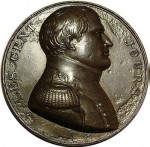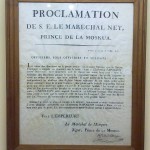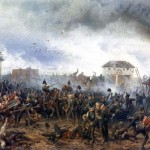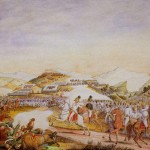The Hundred Days, also known as the War of the Seventh Coalition, marked the period between Emperor Napoleon I of France’s return from exile on Elba to Paris on 20 March 1815 and the second restoration of King Louis XVIII on 8 July 1815 (a period of 111 days). This period saw the War of the Seventh Coalition, and includes the Waterloo Campaign and
the Neapolitan War. The phrase “les Cent Jours” was first used by the prefect of Paris, Gaspard, comte de Chabrol, in his speech welcoming the King. The Treaty of Paris 1815 was the peace treaty that ended the war of the Seventh Coalition against France.
The Seventh Coalition pitted the United Kingdom, Russia, Prussia, Sweden, Austria, the Netherlands and a number of German states against France. Traveling to Paris, picking up support as he went, Napoleon eventually overthrew the restored Louis XVIII. The Allies rapidly gathered their armies to meet him again. Napoleon raised 280,000 men, whom he distributed among several armies. To add to the 90,000 troops in the standing army, he recalled well over a quarter of a million veterans from past campaigns and issued a decree for the eventual draft of around 2.5 million new men into the French army. This faced an initial Coalition force of about 700,000—although Coalition campaign-plans provided for one million front-line troops, supported by around 200,000 garrison, logistics and other auxiliary personnel. The Coalition intended this force to have overwhelming numbers against the numerically inferior imperial French army—which in fact never came close to reaching Napoleon’s goal of more than 2.5 million under arms.
Napoleon took about 124,000 men of the Army of the North on a pre-emptive strike against the Allies in Belgium. He intended to attack the Coalition armies before they combined, in hope of driving the British into the sea and the Prussians out of the war. His march to the frontier achieved the surprise he had planned, catching the Anglo-Dutch Army in a dispersed arrangement. The Prussians had been more wary, concentrating 3/4 of their Army in and around Ligny. The Prussians forced the Armee du Nord to fight all the day of the 15th to reach Ligny in a delaying action by the Prussian 1st Corps. He forced Prussia to fight at Ligny on 16 June 1815, and the defeated Prussians retreated in some disorder. On the same day, the left wing of the Army of the North, under the command of Marshal Michel Ney, succeeded in stopping any of Wellington’s forces going to aid Blücher’s
Prussians by fighting a blocking action at Quatre Bras. Ney failed to clear the cross-roads and Wellington reinforced the position. But with the Prussian retreat, Wellington too had to retreat. He fell back to a previously reconnoitred position on an escarpment at Mont St Jean, a few miles south of the village of Waterloo.
Napoleon took the reserve of the Army of the North, and reunited his forces with those of Ney to pursue Wellington’s army, after he ordered Marshal Grouchy to take the right wing of the Army of the North and stop the Prussians re-grouping. In the first of a series of miscalculations, both Grouchy and Napoleon failed to realize that the Prussian forces were already reorganized and were assembling at the village of Wavre. In any event the French army did nothing to stop a rather leisurely retreat that took place throughout the night and into the early morning by the Prussians.[18] As the 4th, 1st, and 2nd Prussian Corps marched through the town towards the Battlefield of Waterloo the 3rd Prussian Corp took up blocking positions across the river, and although Grouchy engaged and defeated the Prussian rearguard under the command of Lt-Gen von Thielmann in the Battle of Wavre (18–19 June) it was 12 hours too late. In the end, 17,000 Prussians had kept 33,000 badly needed French reinforcements off the field.
Napoleon delayed the start of fighting at the Battle of Waterloo on the morning of 18 June for several hours while he waited for the ground to dry after the previous night’s rain. By
late afternoon, the French army had not succeeded in driving Wellington’s forces from the escarpment on which they stood. When the Prussians arrived and attacked the French right flank in ever-increasing numbers, Napoleon’s strategy of keeping the Coalition armies divided had failed and a combined Coalition general advance drove his army from the field in confusion.
Grouchy organized a successful and well-ordered retreat towards Paris, where Marshal Davout had 117,000 men ready to turn back the 116,000 men of Blücher and Wellington. Militarily, it appeared quite possible that the French could defeat Wellington and Blücher, but politics proved the source of the Emperor’s downfall. In any event Davout was defeated at Issy and negotiations for surrender had begun.
On arriving at Paris three days after Waterloo, Napoleon still clung to the hope of a concerted national resistance; but the temper of the chambers, and of the public generally, did not favour his view. The politicians forced Napoleon to abdicate again on 22 June 1815. Despite the Emperor’s abdication, irregular warfare continued along the eastern borders and on the outskirts of Paris until the signing of a cease-fire on 4 July. On 15 July, Napoleon surrendered himself to the British squadron at Rochefort.
Meanwhile in Italy, Joachim Murat, whom the Allies had allowed to remain King of Naples after Napoleon’s initial defeat, once again allied with his brother-in-law, triggering the Neapolitan War (March to May, 1815). Hoping to find support among Italian nationalists fearing the increasing influence of the Habsburgs in Italy, Murat issued the Rimini
Proclamation inciting them to war. But the proclamation failed and the Austrians soon crushed Murat at the Battle of Tolentino (2 May to 3 May 1815), forcing him to flee. The Bourbons returned to the throne of Naples on 20 May 1815. Murat tried to regain his throne, but after that failed, a firing squad executed him on 13 October 1815.




